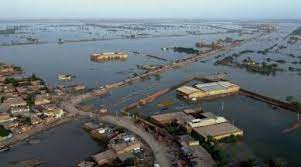ISLAMABAD, Sept 17: An estimated 16 million children have been impacted by “super floods” in Pakistan with at least 3.4 million of them needing immediate lifesaving support, the UN has said.
The situation is extremely grim in flood-hit areas with malnourished children battling diarrhoea, dengue fever, and several painful skin diseases, United Nations International Children’s Emergency Fund (Unicef) representative Abdullah Fadil said in a statement on Friday.
Fadil, who recently concluded a two-day visit to the flood-affected areas of Sindh, said floods had now claimed the lives of at least 528 children.
“Each and every one of these deaths is a tragedy that could have been averted,” he said.
“An estimated 16 million children have been impacted by these ‘super floods’ and at least 3.4 million girls and boys remain in need of immediate, lifesaving support.
“Young children are living out in the open with their families, with no drinking water, no food, and no livelihood, exposed to a wide range of new flood-related risks and hazards – from damaged buildings, drowning in flood waters and snakes. The vital infrastructure that children so rely on has been destroyed and damaged, including thousands of schools, water systems and health facilities,” he said.
As the magnitude of the flood disaster continues to unfold, international aid continues to trickle in.
“The sad reality is that without a massive increase in support and aid, many more children will lose their lives,” the Unicef representative said.
A lot of the mothers are anaemic and malnourished themselves and have very low-weight babies. Mothers are exhausted or ill and they are unable to breastfeed, he said.
Millions of families have been forced from their homes, now living with little more than rags to protect themselves from the scorching sun as temperatures in some areas pass 40 degrees Celsius, he added.
“Many families have been forced to seek shelter on slivers of higher ground, often alongside roads putting children at risk, as lower land is covered by huge expanses of stagnant water, extending as far as the eye can see. The additional threats of snakes, scorpions and mosquitoes are ever-present in the area,” Fadil said.
“Whilst the number of children lost in these floods continues to grow, Unicef is doing everything it can to support children and families affected and protect them from the ongoing dangers of water-borne diseases, malnutrition and other risks,” he added.
The Japanese government decided on Friday to extend emergency grant aid of USD 7 million to Pakistan in response to damages caused by the flood disaster.
Of the USD 7 million, World Food Programme will get USD 2.5 million; the International Organization for Migration (IOM) USD 1.5 million for shelter and non-food items; Unicef USD 1 million for water, sanitation and hygiene; UNHCR USD 1 million for protection, non-food items; and International Federation of Red Cross and Red Crescent Societies USD 1 million for health and medical care, the statement said.
The Canadian government has announced to match individual donations up to a total of 3 million Canadian dollars through the Humanitarian Coalition of 12 charitable organisations collecting funds and donations in Canada in response to flooding in Pakistan.
Meanwhile, over 90,000 people were treated for infectious and water-borne diseases in a day in flood-hit areas of Sindh, government data showed on Friday, as the total death toll from the inundations surpassed 1,500.
Flooded areas have become infested with diseases, including malaria, dengue fever, diarrhoea, and skin problems, according to a Sindh government report.
The floods triggered by the record rains in three decades have claimed 1,545 lives while another 12,850 people have been injured, according to National Disaster Management Authority. (PTI)
Trending Now
E-Paper


